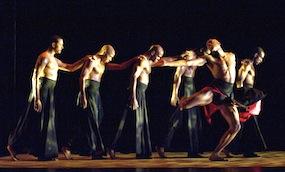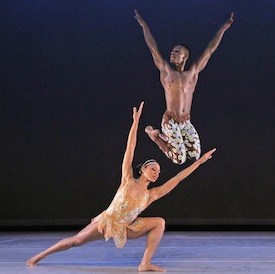
Photo by Andrew Eccles
Robert Battle’s arrival as artistic director of the Alvin Ailey American Dance Theater could not have come at a more propitious time. Anointed by the retiring Judith Jamison, the iconic leader who stepped into Ailey’s shoes following his death from AIDS in 1989, Battle bids fair to guide the company in exciting new directions that pay tribute to the strengths of the old. In two programs — Thursday evening and Saturday afternoon — that were part of a week-long visit to Cal Performances at UC Berkeley, Battle presented works from a diverse array of modern choreographers that fit beautifully with the expansive range and depth of this remarkable troupe. This constitutes a repertory upgrade. Perhaps the most interesting new addition is Paul Taylor’s 1981 classic, Arden Court, in a performance Saturday afternoon that had the audience screaming. And that was the opening piece.
Battle got to know Taylor’s repertory as a Juilliard student, studying with Taylor dancer Carolyn Adams; Ailey was a Taylor fan as well. On Saturday, it was as if the dancers had been just itching to unleash Taylor’s brilliant blend of wit and suppleness, courtly gallantry (via the William Boyce music), and fireworks.
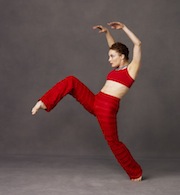
Photo by Andrew Eccles
The men leaped tirelessly; the women, curving lissomely into their roles as wily helpmeets, were all charm and — in impeccably balanced turns — precision; the little jokes, like the men’s sneaky handstand and the unexpected instant replay, looked perfect. The great thing about adding Taylor is that people who haven’t seen his work will probably want to see more of it. So repertory expansion is an audience builder for both companies.
Battle contributed two terrific dances to Saturday’s program. A solo, Takademe (1999), set to an intensely rhythmic song by Sheila Chandra, a British singer of South Indian heritage, is a tour de force. It combines elements of Indian dance, notably Kathak, mingling at top speed with sheer whimsy, superbly and engagingly presented by Antonio Douthit, bare-chested and in bright red Missoni pants. Douthit’s feet pattered, his head spun, torso contracted, feet flexed, arms twitched, and it was impossible to look away. At the end, startlingly, he fell flat on the stage. Blackout. Audience, again, agog.
The conclusion of Battle’s The Hunt (1989) featured a similar fall, which will hereinafter be referred to as a splat, and although stunning to behold, it is a worrying thing. It doesn’t sound like something anyone, even a dancer, should do. But onward.
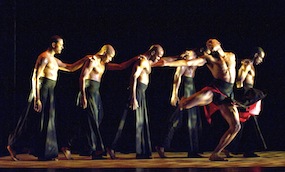
Photo by Ellen Crane
Set to a wall of sound created (on tape, like all the music) by the drumming ensemble Les Tambours du Bronx, The Hunt succeeds in simultaneously evoking ancient and modern worlds. We could be in the Bronx or in Africa or maybe around the corner; the focus is on six men. They’re friends, or allies, or rivals. They’re combative, supportive, confident, and entirely compelling.
They’re wearing Mia McSwain’s floorlength black skirts, lined in scarlet, evocative of sarongs. Having survived an epidemic of men costumed in skirts, your reviewer can say that this time they make aesthetic and practical sense. They’re manly, functional and accentuate the gorgeousness of the ceaseless pyrotechnic challenges — leaps and rolls, pugilism, and crawls, soaring moves with arms extended, all fearlessly undertaken. The superb and tireless dancers were Renaldo Gardner, Daniel Harder, Michael Jackson Jr., Sean A. Carmon, Michael Francis McBride, and Kanji Segawa.
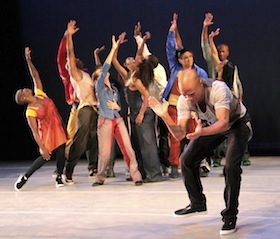
Photo by Paul Kolnik
Thursday night’s program included Ulysses Dove’s Urban Folk Dance and Rennie Harris’s Home. Of the two, Dove’s work, made in 1990 to music of Michael Torke, is the more keenly focused on story, conveyed through two couples — Ghrai DeVore and Antonio Douthit; Demetia Hopkins and Kirven James Boyd — who, side by side in identical kitchens suggesting two apartments, convey moments of combat and accommodation strictly through the exacting positions of their bodies, often in relation to the table and chairs. The ceaseless journey between tension and release was beautifully and often poignantly enacted — without a moment of acting. Home (2011, music by Dennis Ferrer and Raphael Xavier), for a cast of 14, is supposed to reflect upon the impact of the AIDS epidemic. Despite its sponsorship by Bristol-Myers Squibb, Home’s message was, to say the least, indirect. The dancers were a steady, mutually supportive cluster, and their dances, vital and energizing, suffused with hip-hop and other street vernacular, appeared to be in defiance of the scourge.
Revelations, Ailey’s 1960 gospel-infused masterwork, concluded every performance during the visit. It was a bit off-kilter Thursday night, but Saturday it looked marvelous, highlighted by the regal Alicia Graf Mack, bearing the white, ruffly umbrella in Wade in the Water, and Akua Noni Parker and Yannick Lebrun in Fix Me, Jesus.

